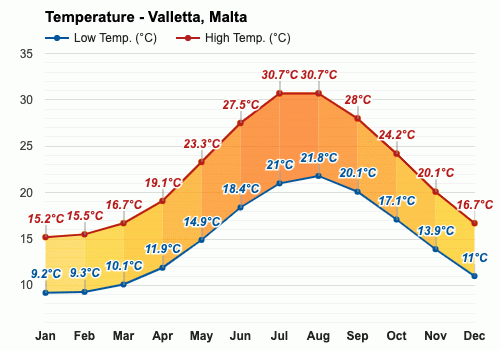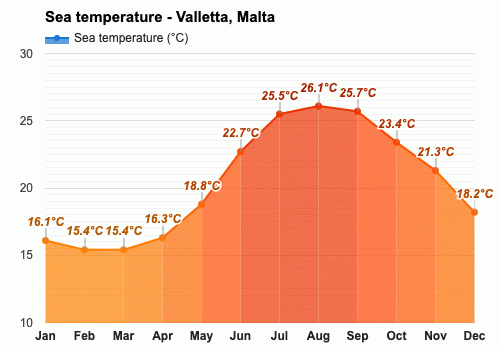
March
Weather in March
Temperature
Valletta records a slight change with March's average high-temperatures adjusting to an enjoyable 16.7°C (62.1°F) from February's 15.5°C (59.9°F). Valletta reports an average low-temperature of 10.1°C (50.2°F) during the nights of March.Rainfall
In Valletta, in March, during 9 rainfall days, 41mm (1.61") of precipitation is typically accumulated. Throughout the year, there are 80 rainfall days, and 553mm (21.77") of precipitation is accumulated.Sea temperature
February and March, with an average sea temperature of 15.4°C (59.7°F), are months with the coldest seawater.Note: Swimming in 15.4°C (59.7°F) is not enjoyable for the majority. Controlling breathing becomes progressively more difficult as surface water temperature decreases below 21°C (69.8°F).
Daylight
In Valletta, the average length of the day in March is 11h and 59min.On the first day of March, sunrise is at 6:31 am and sunset at 5:57 pm. On the last day of the month, sunrise is at 5:48 am and sunset at 6:23 pm CET.
Sunshine
The average sunshine in March is 7.3h.UV index
In Valletta, Malta, the average daily maximum UV index in March is 5. A UV Index value of 3 to 5 symbolizes a moderate health risk from exposure to the Sun's UV radiation for the average person.Note: The UV index of 5 during March leads to these advisories:
Act with care - Obligation to protect against skin and eye damage is highlighted. Solar radiation peaks around mid-day, so it's wise to limit exposure to the Sun at this time. Experience reduced UV exposure by about half when donning a wide-brim hat.
Published by: Weather Atlas | About Us
Data Sources | Weather Forecasting & Climate
Frequently asked questions
What are the temperatures in March?
How many days does it rain in March?
What months are the sea coldest?
How cold is the water in March?
How many hours of daylight does Valletta have in March?
When are sunrise and sunset in March?
How long on average sun shines in March in Valletta?
What is the UV index reading in March?

Average temperature in March
Valletta, Malta
- Average high temperature in March: 16.7°C
The warmest months (with the highest average high temperature) are July and August (30.7°C).
The month with the lowest average high temperature is January (15.2°C).
- Average low temperature in March: 10.1°C
The month with the highest average low temperature is August (21.8°C).
The coldest month (with the lowest average low temperature) is January (9.2°C).

Average rainfall in March
Valletta, Malta
- Average rainfall in March: 41mm
The wettest month (with the highest rainfall) is December (112mm).
The driest month (with the least rainfall) is July (0mm).

Average rainfall days in March
Valletta, Malta
- Average rainfall days in March: 9 days
The months with the highest number of rainy days are January and December (13 days).
The month with the least rainy days is July (0 days).

Average sea temperature in March
Valletta, Malta
- Average sea temperature in March: 15.4°C
The best month for swimming (with the highest average sea temperature) is August (26.1°C).
The coldest months (with the lowest average sea temperature) are February and March (15.4°C).

Average daylight in March /
Average sunshine in March
Valletta, Malta
- Average daylight in March: 12h and 0min
The month with the longest days is June (Average daylight: 14h and 36min).
The month with the shortest days is December (Average daylight: 9h and 48min).
- Average sunshine in March: 7h and 2min
The month with the most sunshine is July (Average sunshine: 12h and 6min).
The month with the least sunshine is December (Average sunshine: 5h and 12min).

Average UV index in March
Valletta, Malta
- Average UV index in March: 5
The months with the highest UV index are June and July (UV index 10).
The months with the lowest UV index are January and December (UV index 2).


